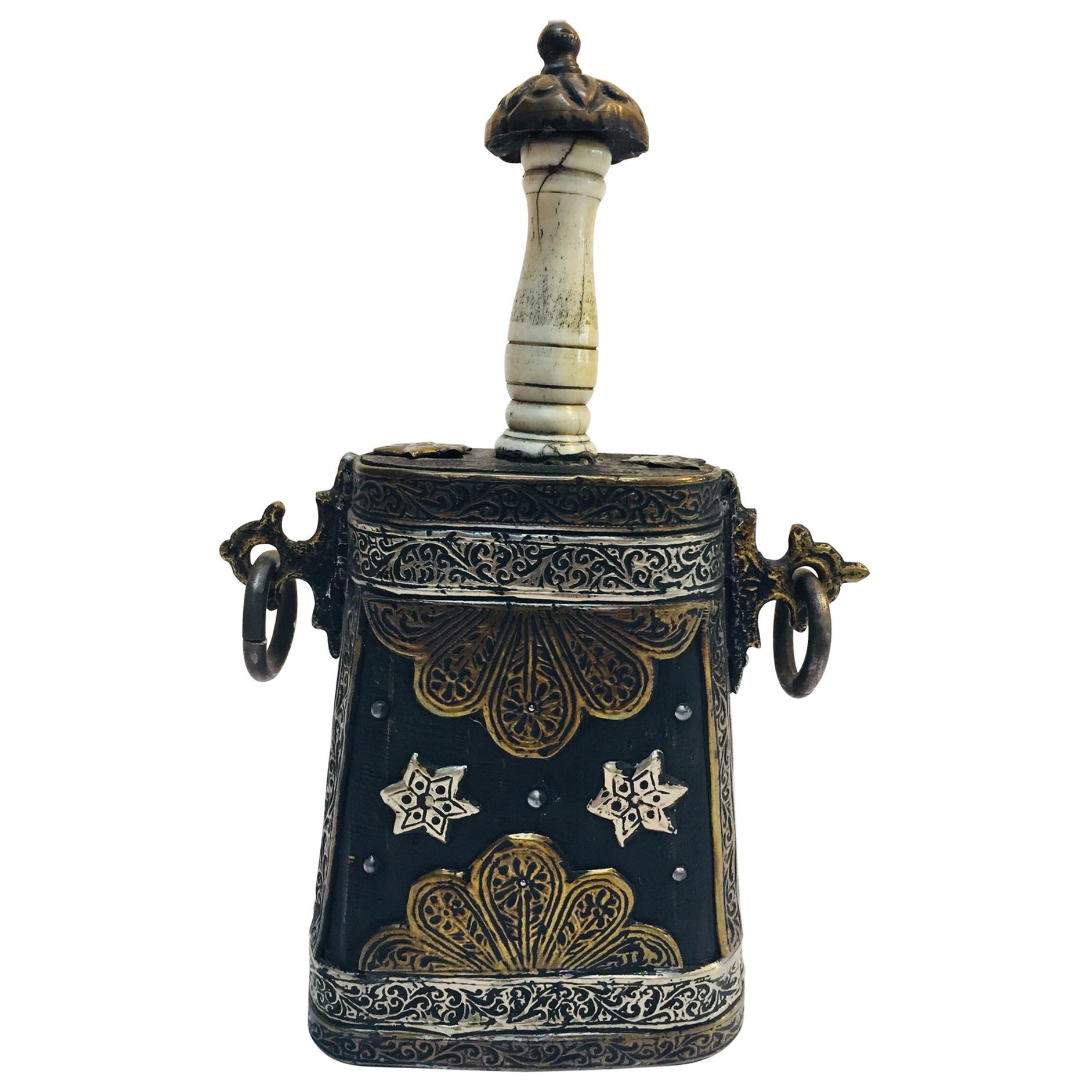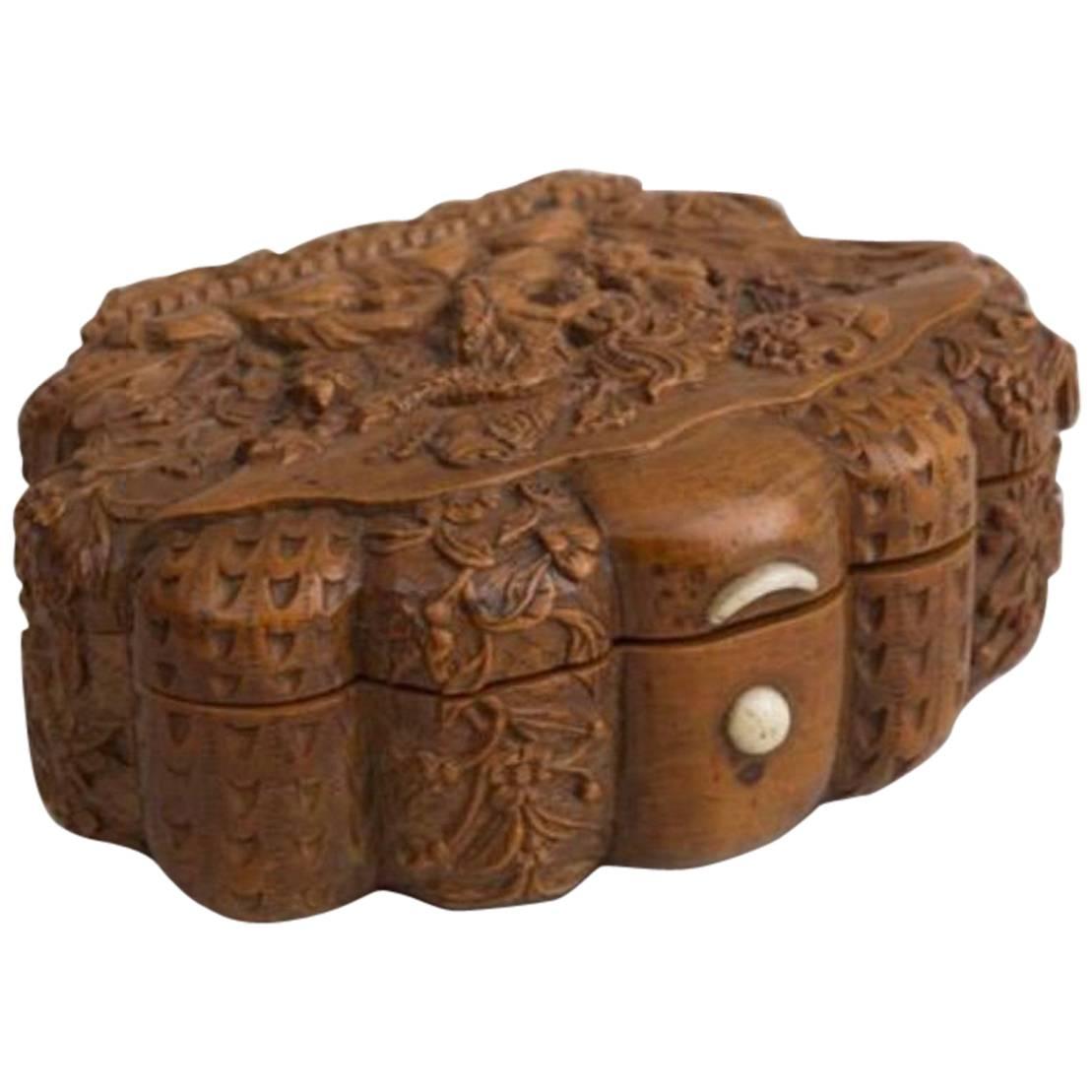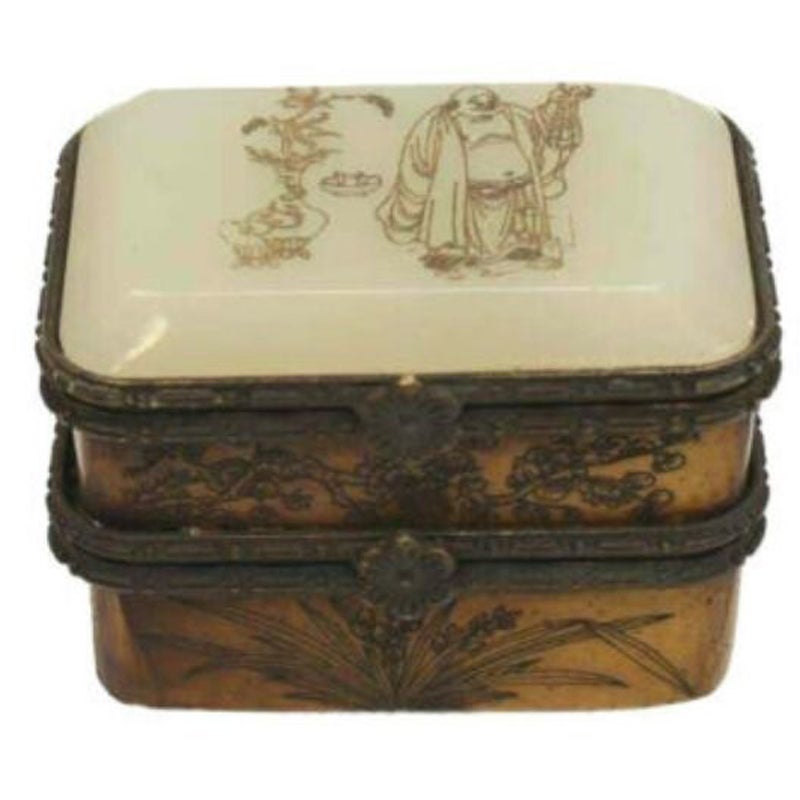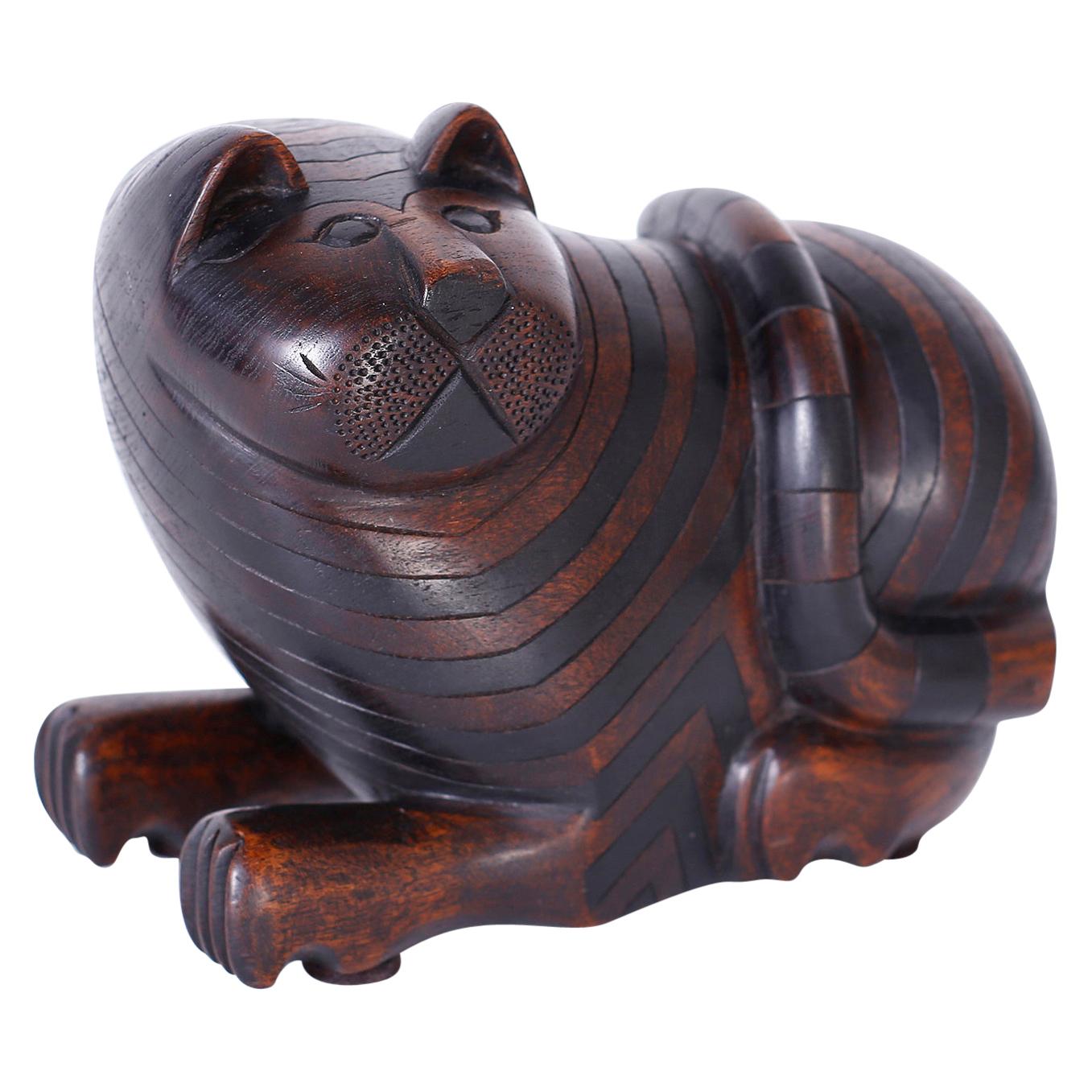Items Similar to French 1750 Antique Double Compartment Pocket Snuff Flask Carved In Coquille Nut
Want more images or videos?
Request additional images or videos from the seller
1 of 5
French 1750 Antique Double Compartment Pocket Snuff Flask Carved In Coquille Nut
About the Item
Pocket snuff flask carved from coquille nut.
Amazing small pocket snuff bottle, carved from a large coquille nut. This antique piece was created in the shape of a spinning top with two secret compartments which can be unscrewed to open. Made in the continental Europe and most probably French or Portuguese provenance from the 18th century, circa 1780. Extensively decorated with organic and floral motifs with a beautiful image of a nut on the upper part.
Curiously due to the shape of this piece, it could be played as a spinning tool on a table. This adds a particular interest for the multiple use with which the carving was conceived.
Weight: 42.60 Grams.
Measurements: Diameter of 40 mm and a height of 89 mm (1.57 x 3.5 Inches).
Hallmarks: No marks, gorgeous deep antique patina.
Coquille Nut
The coquille nut emanates from swampy areas on the eastern side of South America, from a palm known as the “attalea funiefera”. Brazilians call it “Piassabe”. The nuts were introduced into Western Europe in the mid-16th century, and used for small carved objects until the end of the 19th century. Coquille nut is a fruit of a Brazilian palm, closely related to the coconut palm. Its a fruit, of about 3 to 4 in. (7.6–10.2 cm) long, is very hard, of a richly streaked brown, and capable of taking a fine polish; it is used in cabinetwork and for umbrella handles. More important economically is the stiff, wiry, bright chocolate-colored leaf fiber, called piassava or piassaba, obtained from this and similar palms. It is used in making brooms and rope, and is an important export product in Amazonian South America. The nut is also a source of palm oil. Coquille nuts are classified in the division Magnoliophyte, class Liliopsida, order Arecales, family Arecacae (Palmae).
Snuff bottles
Snuff boxes or snuff bottles were used for containing snuff, a mixture of ground tobacco and scented oils, and were very popular in the 18th century when snuff-taking was fashionable. Highly decorated and valuable objects, they became collectors' items in the 19th century
Condition: The overall condition of this piece is excellent. Beside the little normal wear, there is no damage.. All carved parts are secured in the settings. This piece has been carefully inspected to guarantee the condition and authenticity.
INVENTORY REF: D060823SEMH/.3215
- Dimensions:Height: 3.5 in (8.89 cm)Diameter: 1.75 in (4.45 cm)
- Style:Louis XV (Of the Period)
- Materials and Techniques:
- Place of Origin:
- Period:1750-1759
- Date of Manufacture:1750
- Condition:Wear consistent with age and use. The overall condition of this piece is excellent. Beside the little normal wear, there is no damage.. All carved parts are secured in the settings. This piece has been carefully inspected to guarantee the condition and authenticity.
- Seller Location:Miami, FL
- Reference Number:
About the Seller
5.0
Platinum Seller
These expertly vetted sellers are 1stDibs' most experienced sellers and are rated highest by our customers.
1stDibs seller since 2023
63 sales on 1stDibs
Typical response time: <1 hour
- ShippingRetrieving quote...Ships From: Miami, FL
- Return PolicyA return for this item may be initiated within 1 day of delivery.
More From This SellerView All
- French 1790 Antique Snuff Box in 19kt Gold Sterling and Translucent Gray AgateLocated in Miami, FLFrench snuffbox from the late 18th century. Beautiful antique piece, made in France during the late 18th century, circa 1790's. It was carefully carved with impeccable precision, ...Category
Antique 1790s French Louis XVI Snuff Boxes and Tobacco Boxes
MaterialsAgate, Gold, Silver
- French School 1790 Louis XVI Oval Snuff Box in 18kt Gold with Miniature PortraitLocated in Miami, FLPresentation Snuff box from the 18th century French School. A very important and rare Neoclassical oval box, made in Paris, France circa 1790. It was crafted with translucent natu...Category
Antique 1790s French Neoclassical Snuff Boxes and Tobacco Boxes
MaterialsGold
- French 1905 Edwardian Hexagonal Snuff Box Sterling Silver with Guilloche EnamelLocated in Miami, FLA French snuff box from the Edwardian Period. Very beautiful hexagonal box, created in Paris France during the Edwardian period, back in the 1905. ...Category
Antique Early 1900s French Edwardian Snuff Boxes and Tobacco Boxes
MaterialsSilver, Sterling Silver, Enamel
- Russian 1898 Moscow Niello Rectangular Snuff Box in .875 Sterling SilverLocated in Miami, FLRussian snuff box designed by Ivan Sergeyevich Lebedkin. Beautiful snuff box, created in Moscow Russia, at the workshop of Ivan Sergeyevich Lebedk...Category
Antique 1890s Russian Neoclassical Snuff Boxes and Tobacco Boxes
MaterialsSilver, Sterling Silver
- French 1819-1838 Neoclassical Louis XVI Rectangular Snuff Box Labrated 18kt GoldLocated in Miami, FLFrench snuff box in solid gold. Exceptional rectangular snuff box, crafted in Paris France during the second monarchic restoration period, between the 1818 and 1838. It was carefully crafted in the neoclassical Louis XVI style in solid yellow gold of 18 karats. Fitted with a hinged lid and embellished with intricate chiseled, engraved and guilloche finishes, Monogramed AS inside the counterpart of the lid. Weight: 1l7.75 Grams, (75.48 Dwt). Measurements: 89 mm by 54 mm by 20 mm (3.5 x 2.13 x 0.79 Inches). Hallmarks: Stamped with ancient French marks; the Zeus head...Category
Antique 1830s French Neoclassical Snuff Boxes and Tobacco Boxes
MaterialsGold
- Henrik Wigström 1908 Russia Saint Petersburg Enameled Snuff Box in 14kt GoldBy Henrik Wigström 1Located in Miami, FLA snuff gold box designed by Henrik Wigström. Beautiful neo classic snuff box, created in St, Petersburg Russia, at the workshop of Henrik Wigström, back in the 1908. This piece has been carefully crafted in the Russian imperial and Louis XVI styles, in solid yellow gold of 56 zolotnik (14kt) and embellished with applications of white enamel. Decorated around with garlands and intricates dotted patterns. Fitted with an invisible hinge and close perfectly well. Weight: 36.65 Grams, (23.49 Dwt). Measurements: 41 mm by 39 mm by 14 mm (1.61 x 1.53 x 0.55 Inches). Hallmarks: Stamped on both parts with Russian marks; the kokoshnik post 1908 mark with the letter a for the city of Saint Petersburg, the maker's mark HW associated to Henrik Wigström inside an oval cartouche, scratched with his inventory numbers 86111 and the 56 zolotnik mark for the assay and warranty of the gold. Other Hallmarks: Stamped in the outside border, with German importation marks; the German Crown mark, the retailer mark AT inside an oval and the 585 mark for the assay and warranty of the gold. Henrik Immanuel Wigström born on 1862 and was a Finnish silver & goldsmith. He was one of the most important Fabergé workmasters along with Michael Perchin. Perchin was the head workmaster from 1886 until his death in 1903, when he was succeeded by his chief assistant Henrik Wigström. These two workmasters were responsible for almost all the imperial Easter eggs. Henrik Wigström was born in Ekenäs, Finland, and was apprenticed to a local Danish born goldsmith named Peter Madsén, a successful manufacturer of silverware who was familiar with the jewellery trade in the city of St. Petersburg, as at one time he had had a workshop there. Once in Madsén's employment, his master's trade with Russia, as well as his numerous business contacts here, brought him to work in St. Petersburg. Goldsmith Werner Elfström employed Wigström as a apprentice on his arrival in the capital in 1875. Wigström became assistant in 1884, at the age of 22, to Perchin, whose shop at that time was already working exclusively for Fabergé. Wigström became head workmaster at Fabergé after Perchin's death in 1903. The number of craftsmen in Wigström's workshop diminished drastically with the outbreak of World War I. By 1918, the Revolution forced the complete closing of the House of Fabergé. Aged 56, Wigström retreated almost empty-handed to his summer house, on Finnish territory, and died at Terijoki in 1923. His art is similar to Perchin's but tends to be in the Louis XVI, Empire, or neo-classical style. Nearly all the Fabergé hardstone animals...Category
Antique Early 1900s Russian Neoclassical Snuff Boxes and Tobacco Boxes
MaterialsGold, Enamel
You May Also Like
- Early French Wooden Flask, France, c. 1750, Initials Carved on SideLocated in Brooklyn, NYFrench 17th/18th C. Wooden flask, carved with initials.Category
Antique 18th Century French Louis XIII Bottles
MaterialsOak, Walnut
- Moroccan Antique Berber Case Flask Hand-carvedBy Berber Tribes of MoroccoLocated in North Hollywood, CAHand made early 20th century Moroccan antique Berber case flask, carved wood covered with brass and silvered metal filigree, delicately hand-hammered metal with animals decor for pow...Category
Vintage 1920s Moroccan Moorish Tobacco Accessories
MaterialsBrass, Tin
- Fabulous Antique English Penwork Double Compartment Tea Caddy c.1820Located in Bath, GBA simply magnificent and grand example of a Regency Penwork Tea Caddy dating 1820. The caddy stands on it's original large gilded bronze Lion's paw feet and the sides retaining the ...Category
Antique 1820s British Regency Tea Caddies
MaterialsWood
- Chinese Carved White Jade Wood and Bronze Double Compartment Trinket BoxLocated in Gardena, CAChinese carved white jade wood & bronze double compartment trinket box, circa 1900. Dual stacked compartments, circa 1900 or older. Add...Category
Antique 19th Century Decorative Boxes
MaterialsJade
- French Carved Snuff Box, Mid-19th CenturyLocated in Spencertown, NYThe elaborately carved snuff box with a scene of two mermaids on the cover and deeply carved shell on the reverse.Category
Antique Mid-19th Century French Rococo Revival Nautical Objects
MaterialsBoxwood
- Carved Mahogany Cat with Secret CompartmentLocated in Palm Beach, FLAnglo Indian carved mahogany cat with ebonized stripes and a curious expression, featuring a secret compartment on the bottom.Category
Early 20th Century Indian Anglo-Indian Animal Sculptures
MaterialsMahogany
Recently Viewed
View AllMore Ways To Browse
Tobacco Leaf Box
Sniffing Box
Hand Painted Snuff Jar
German Porcelain Snuff Boxes
Gold Bar 1 Oz
Indian Snuff Box
Music Snuff Box
Vintage Snuff Jar
Vintage Snuff Jars
Cloisonne Enamel Cigarette Case
Faberge Cigarette Box
Gebruder Dingeldein
Opium Container
Tabacco Leaf
Snuff Box Spoon
Snuff Faux
Tobacco Leaf Box
Porcelain Snuff Box





